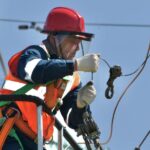Steam turbines play an important role in power generation across various industries, including industrial captive power plants, independent power producers (IPPs), oil & gas plants, and utility power plants. Consistent maintenance of various steam turbine components can help enhance efficiency, extend operational life, and reduce the likelihood of costly downtime.
Here are key aspects of the maintenance of various parts of steam turbines to consider:
Rotor and Blades Maintenance
The rotor and blades are crucial components that influence the efficiency of steam turbines. Over time, they can experience wear and tear due to high-speed rotation and continuous exposure to steam. Regular inspection, cleaning, and surface polishing can help mitigate erosion and corrosion. Advanced techniques such as 3D scanning and Non-Destructive Testing (NDT) may help identify minor defects before they develop into significant issues.
Proper balancing of the rotor may contribute to vibration-free operation, reducing stress on the bearings and improving the performance of the steam turbine. Ensuring the ongoing reliability of steam turbines depends on the proper maintenance of these critical components.
Bearings and Lubrication System
Bearings support the rotating shaft and require ongoing lubrication to reduce friction and heat generation. Periodic oil analysis can help detect contamination, degradation, or insufficient lubrication, which could lead to overheating and premature wear.
Maintaining optimal oil viscosity and ensuring filtration systems are free of debris are important for prolonging bearing life and reducing the chances of unexpected shutdowns. Insufficient lubrication may result in significant damage to steam turbine components and lead to costly repairs.
Steam Seal Inspection
Steam seals are designed to prevent leakage and maintain pressure levels within the steam turbine. If seals become worn or damaged, steam loss can result in reduced efficiency and higher fuel consumption. Regular inspection and timely replacement of worn seals can help reduce leakage and maintain optimal steam flow.
Proper alignment and installation of sealing rings can enhance steam turbine efficiency and reliability. Effective maintenance of steam seals is necessary for protecting the critical components of steam turbines.
Casing and Structural Integrity
The steam turbine casing serves to protect internal components from external damage and environmental exposure. Cracks, misalignments, or loose bolts in the casing could lead to operational inefficiencies. Frequent visual inspections, along with ultrasonic testing and thermal imaging, can assist in the early detection of structural weaknesses.
Maintaining proper alignment and securing fasteners may help prevent excessive vibrations and pressure imbalances that might lead to significant failures. Protecting the integrity of the casing is vital for ensuring the safety and longevity of various steam turbine components.
Control Systems and Instrumentation
Steam turbines rely on precise control systems and instrumentation for efficient operation. Malfunctioning sensors, actuators, or control valves could result in improper steam flow regulation and reduced efficiency. Routine calibration, software updates, and diagnostic testing can help ensure that the control systems function as intended. Modern digital monitoring solutions allow for real-time performance tracking and predictive maintenance, which may help ensure that all parts of steam turbines operate smoothly.
Maintaining the different parts of steam turbines is important for ensuring optimal performance, efficiency, and reliability. These efforts can be further improved by partnering with manufacturers like Triveni Turbines, which offer specialized maintenance services aimed at supporting maximum performance and reliability.

















